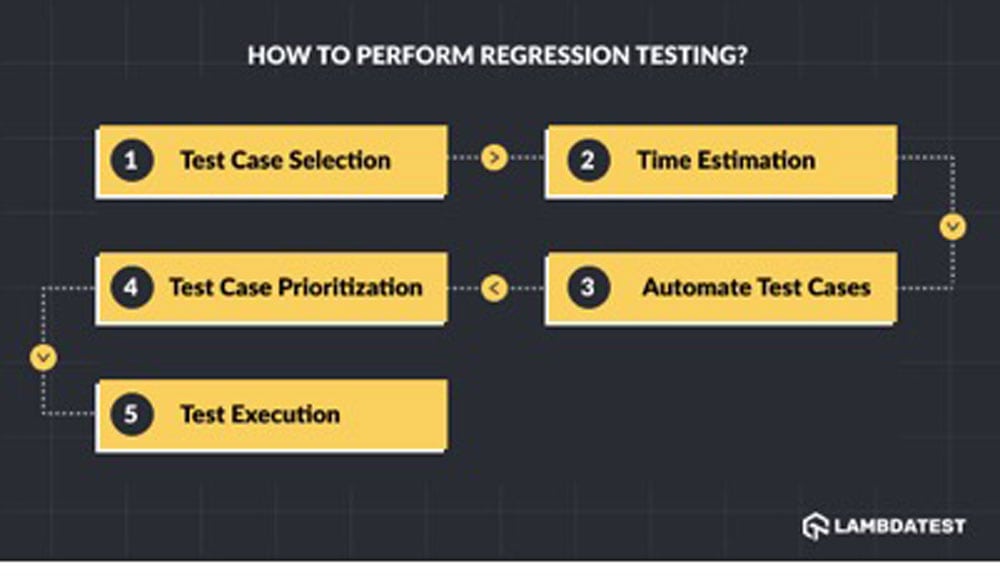In the world of software development, changes are expected. Whether up-grading existing ones, adding new features, fixing bugs, or code changes are a continuous part of the process. Yet, after a bug gets fixed, other bugs often arise. Hence, how can we ensure that the bug fixes or sudden code changes don’t introduce new issues? This is when Regression testing comes to the rescue.
It ensures that bug issues do not arise after any code change. By conducting regression tests, quality assurance, and developers teams can detect and fix any unexpected issues that may arise due to code modifications.
What is Regression Testing?

READ MORE: Gen V Season 2 Release Date, Cast, Plot, Theories & Predictions
Regression testing is a vital form of the software development process’s quality control process that checks whether current modifications or updates to software have unintentionally introduced new bugs or negatively impacted earlier functional aspects. Its main objective is to confirm that alterations intended for enhancement don’t disrupt the established reliability and performance of the software.
How to perform Regression Testing?
Regression tests can be performed both manually and automatically. QA Engineers mainly utilize special methods and techniques to run Regression tests.
Below are the stages involved in Regression tests –
- Test Case Selection
- Time Estimation
- Automate Test Cases
- Test Case Prioritization
- Test Execution
Necessity of Regression Testing

Credit: Pexels
READ MORE: Elite Season 8 Release Date, Cast, Plot, Theories & Predictions
Regression test is a crucial part of the software testing process, and it’s essential for multiple reasons:
- Change in Requirements: When there is a modification in the project scope or requirements, it sometimes results in changes in the current code. Regression testing ensures that these modifications don’t introduce new bugs or defects in the functionality.
- New Feature Development: When fresh functionalities or features are added to a software product, it’s significant to check that these add-ons don’t adversely impact the current features. Such a form of testing helps ensure that the new features function as intended and don’t break the current ones.
- Performance Improvement: Often, performance-centric problems are detected in the software, and optimizations are made to improve the overall performance. Regression testing guarantees that these optimizations don’t negatively affect other features of the application.
- Bug Fixing: When bugs or defects are detected in the software, testers make modifications to fix these bugs. Regression testing is vital to check that the fixes don’t introduce new errors in the codebase.
- Code Maintenance: As software projects progress, code maintenance is a constant procedure. Regression test plays a critical role in confirming that ongoing code alterations don’t have unintended penalties on the software’s functionality and steadiness.
Pros and Cons of Regression Tests
Pros
- Detects bugs and issues introduced by code updates or changes.
- Ensure issues that are already fixed don’t reoccur.
- Gives instant feedback to developers after code alterations.
- Reduces the risk of introducing new errors into the software.
- Simple to learn and easy to understand and analyze.
- Verifies multiple aspects of the software to ensure comprehensive testing.
Cons
- Without automation, regression tests can be arduous and time-consuming.
- Need to run for every minor change of code.
- A highly repetitive procedure might affect the agile sprint.
- Managing and prioritizing test suites while regression can become intricate.
- Needs you to create difficult test cases.
- Tests might depend on each other, making isolation of problems challenging.
3 Most Significant Techniques of Regression Testing

Credit: Pexels
READ MORE: Goosebumps Season 2 Release Date, Cast, Plot, Theories & Predictions
1. Retest everything
This method involves retesting the complete app or a significant part of it after every code alteration or modification. It makes sure that no current functionality has been unpleasantly affected by the recent modification. For instance, complete regression is the ideal choice when an app is moved to a new platform or when there is an update to fix a major bug in the Operating System.
Let’s find the step-by-step process for re-testing:
- Recognize the Defect: Start by finding the issue or defect reported in the previous version.
- Test Case Implementation: Implement the specific test cases that failed because of the defect in the earlier version.
- Verification: Validate that the problem no longer exists or has passed.
Use Cases:
Re-tests are mainly useful when making substantial changes, employing critical bug fixes, or fixing security risks or vulnerabilities.
Benefits:
Gives comprehensive test coverage, guarantees the reliability of the web app, and is effective for critical updates.
2. Selection of Regression Testing
In this method, you have the option to select the portions on which one can run regression testing. The relevant portions are chosen based on the scale of the impact the modifications can have on the app. Besides, with such a method, partial test cases are applied to associated areas, decreasing the effort, time, and resources required for regression tests.
Let’s find the step-by-step process in selective testing:
- Test Case Selection: Detects the test cases that cover the parts of the app influenced by current code changes.
- Test Execution: Implement the selected test cases to validate that the modifications haven’t introduced any new flaws or regressions.
Use Cases:
This method is employed when resources are restricted, and exhaustive tests of the complete app are impractical. It is also appropriate for projects with recurrent updates.
Benefits:
Saves extra time and effort and is effective for projects with regular iterations.
3. Test case Prioritization
Test case prioritization is an essential technique in regression testing that empowers QA and development teams to optimize their efforts by recognizing and implementing the significant test cases first. This strategic method makes sure that business-centric, high-impact functionalities are comprehensively tested while also fast-tracking the testing process.
Let’s find the step-by-step process for test case prioritization:
- Identify Critical Test Cases: This primary phase is to find and categorize test cases based on their criticality. You have to define which test cases cover the higher critical functionalities.
- Scrutinize Recent Code Modifications: Before prioritizing test cases, it is crucial to understand the current code updates or changes in the software.
- Prioritization Metrics and Criteria: Establish clear prioritization metrics and criteria. These benchmarks should align with the objectives of your test effort.
Use Cases:
Test case prioritization is crucial when you wish to confirm that the main functionalities are carefully tested before others. It is also important for testing freshly incorporated traits.
Benefits:
Make sure that the noteworthy functionalities are perfectly tested, give speedy feedback on crucial issues, and lessen the threat of high-impact flaws.
What are the benefits of Regression Testing?

Credit: Pexels
READ MORE: Bodies Season 2 Release Date, Cast, Plot, Theories & Predictions
Regression testing is a crucial part of the QA process. It serves multiple purposes, making it a crucial practice for any software development project. Here are the key benefits and rewards of regression testing:
- Detecting Regressions: The main purpose of this form of testing is to detect regressions or unintentional adverse effects that occur when fresh features or code changes are introduced. Such regressions can include new errors or the recurrence of earlier fixed problems.
- Confirming Code Stability: As a software project progresses, developers constantly make modifications to the codebase. Such changes can introduce flaws or disrupt current functionalities. The regression test helps confirm that the current functionality remains steady regardless of ongoing development.
- Validating Bug Fixes: When any error is reported and then fixed, a regression test helps ensure that the bug has been effectively resolved. It controls the recurrence of similar problems in future releases.
- Supporting CI/CD: In CI/CD pipelines, code modifications are frequently incorporated, tested, and employed. Regression test plays a crucial role in such pipelines by rapidly verifying that modifications don’t break current functionality, enabling rapid deployments.
- User Satisfaction: Constantly delivering a steady and error-free software application is crucial for user satisfaction. Recurring regression testing confirms that the software meets customer expectations and performs unfailingly.
- Managing High-Quality: This form of testing is critical to maintain the entire quality of the software app. By rapidly detecting and fixing flaws, it prevents the accumulation of flaws that can hinder user experience and the overall quality of the product.
- Security and Compliance: In industries with regulatory supplies (such as finance or healthcare), this type of testing helps guarantee that software remains compliant with regulations. It also aids in determining security threats that may arise because of code changes.
- Risk Mitigation: This type of testing mitigates the threats linked with software updates and launches. It gives confidence to stakeholders that modifications will not depressingly impact the business operations or user experience.
- Cost-Effectiveness: Detecting and fixing issues early in the software development cycle is more lucrative than dealing with them later. This form of testing catches flaws early, reducing the resources needed for fixing defects or troubleshooting.
- Automated Tests: This form of testing can be automated, enabling the recurrent implementation of test cases without manual interference. Automation saves precious time and guarantees thorough and reliable testing.
Four Significant Tools to Successful Run Regression Testing
Selenium
It is an open-source and automated testing tool for testing and scrutinizing sites and web apps. It is considered one of the best Regression test tools for web app tests. This incredible tool supports various platforms and web browsers for automated browser tests. You can execute your automated visual regression testing with Selenium on LambdaTest, an AI-powered test orchestration and test execution platform. This platform can easily run across 3000+ real browsers and OSes. It also lets you run Selenium Visual Tests on the Cloud that capture and relate screenshots and deliver a smooth user experience.
Watir
It is one of the most preferred web app testing frameworks in Ruby. Watir is an open-source Ruby library to automate web browser tests. It is a testing tool that is utilized to automate test suites.
Silk Test
It is an automated Regression and functional tests tool for enterprise software apps. Silk Test aids with cross-platform, regression, and localization tests of all mobile app types like native, hybrid, and web apps.
QA Wizard
QA Wizard Pro is one of the most critical tools that automate Regression and functional tests of Windows, Java, and web apps and performs load tests of web applications.
What are the key challenges of Regression Testing?
- Test suite time and cost: A Regression test suite needs continuous upgrading when new features are deployed. Therefore, the number of test cases differs, and new tests should be re-run with older ones, which require extra time and expense to complete.
- Intricate test cases: As the app or project becomes highly intricate, the no. of test cases and their complication also rise. Thus, consuming an important amount of resources and time.
- Maintenance: As the app progresses in size, the intricacy of test cases in Regression test suites rises. Hence, proper maintenance is crucial to maintain the complexity and implementation time.
Final Verdicts

Credit: Pexels
READ MORE: When Will The Wheel Of Time Season 3 Be Released On Prime Video?
Regression testing is a crucial QA practice that manages software performance after code alterations. By employing methods like selective testing, re-testing, and automated regression testing, QA and development teams can smartly update their software while reducing the threat of introducing fresh flaws or defects. These important techniques are pivotal in delivering superior-quality software and guaranteeing customer satisfaction.
Don’t forget if you think Regression testing is intricate; there are always platforms like LambdaTest to assist you. You can also fast-track your Visual regression test journey with this pristine platform for pixel-by-pixel contrast and detect Visual UI mismatches.
Frequently Asked Questions (FAQs)
Are these regression testing methods exclusive, or can they be combined?
These techniques aren’t exclusive and can be combined based on your requirements. For instance, you may utilize “Re-test Everything” first and then follow up with “Test Case Prioritization” to confirm complete coverage while also aiming at critical areas.
What is the best time to run regression testing?
The best time to run regression testing is at multiple steps throughout the software development lifecycle. It must be incorporated into your development procedure to catch flaws early, ensure software stability, and smooth timely releases. Moreover, automated regression test tools can help streamline and fast-track the testing process, making it stress-free to run regression tests at several intervals.














